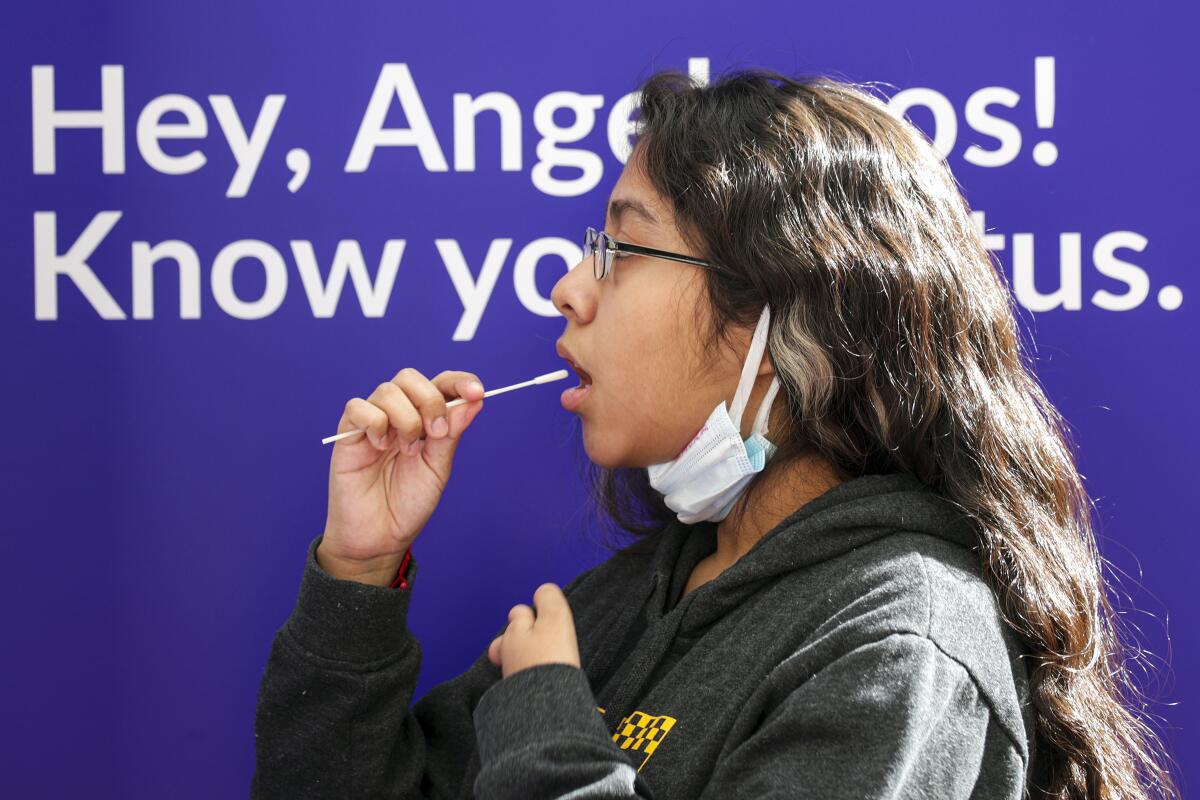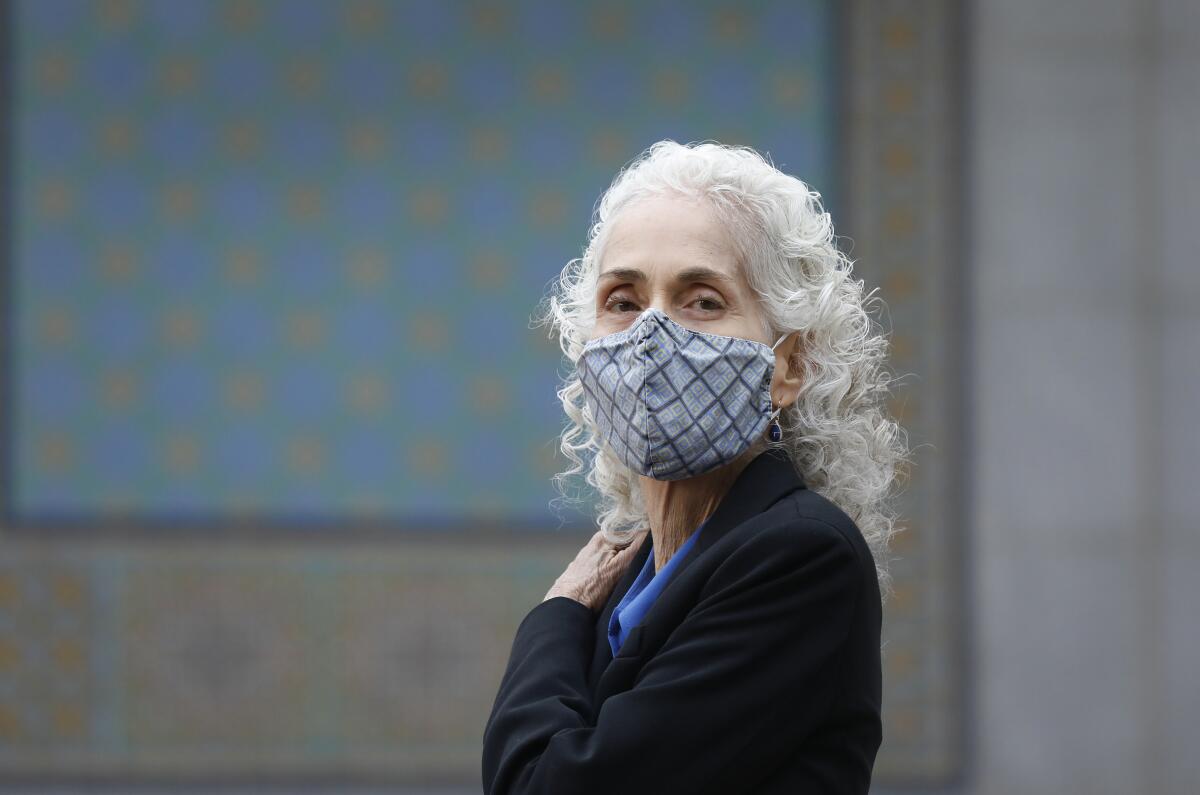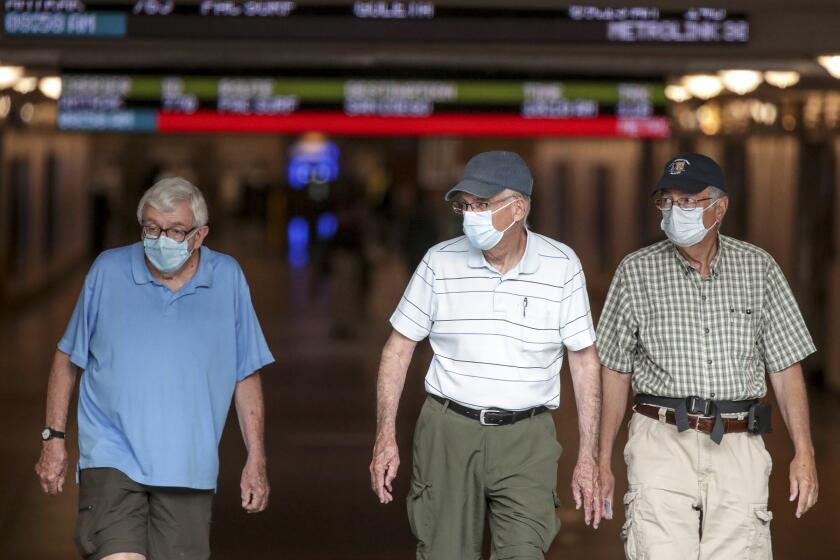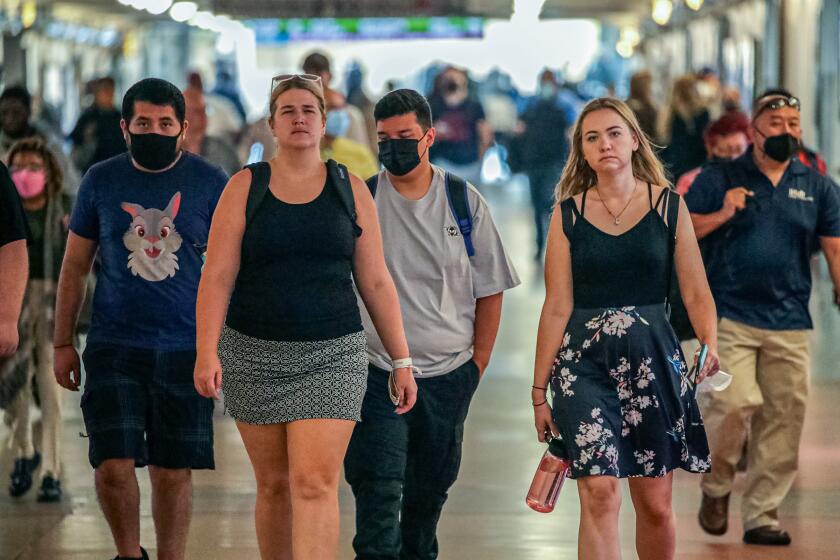Just how big is this COVID surge? As reported tests fall off, it’s harder to say

In Sherman Oaks, Julia Irzyk tries to gauge how rampant the coronavirus is in her community, turning to a constellation of data points to guide her.
“I have very little confidence that I would survive COVID,” said Irzyk, who is more vulnerable to the coronavirus because she has lupus and other health conditions.
So Irzyk keeps track of hospitalizations and deaths. She checks data from wastewater monitoring that predicts spikes in the coronavirus. Recently, troubled by what she was seeing in the numbers, she told employees at her talent agency to stop coming to work in the office.
But she puts little stock in one of the simplest numbers regularly shared by health officials: How many COVID-19 cases are being reported.
Those official figures are “relatively worthless at this point,” said Irzyk, who authored a book on disability and the law. “Positive tests are being discovered through home testing — and they’re not reported to anyone.”
The boom in home testing for the coronavirus has meant that health officials never hear about many COVID cases, deflating official counts.
Federal funding to test uninsured patients also dried up this spring, pinching the availability of free testing for some Americans. California has sought to continue providing testing for uninsured people through its own programs, and in Los Angeles County, the Department of Health Services said the number of its own sites — which offer COVID testing without out-of-pocket charges to L.A. County residents — has remained stable since the beginning of this year.
But official testing has nonetheless fallen off even as California reckons with the rapid spread of the BA.5 subvariant.
In L.A. County, an average of more than 222,000 tests were being recorded daily in January; in June, that figure had dropped to around 77,000 tests a day. Those figures do not include tests taken at home; the public health department said it currently has no system in place for people to report such results to L.A. County.
The subvariant BA.5 made up 65% of U.S. coronavirus cases over the week ending Saturday. A month ago, it made up 17% of cases.
At the University of Washington, researchers who test blood to assess the true level of infections have estimated that only 14% of cases are being reported across the United States. Testing has never captured the full spread of the coronavirus, but the figure is much lower than in some earlier points in the pandemic, when more than 40% of cases were once estimated to be detected.
“Even the cases that are being detected are not being reported as frequently as they used to be,” said Ali H. Mokdad, professor of health metrics sciences at the university’s Institute for Health Metrics and Evaluation. “In many states, many counties, it’s only once a week.”
Between the rise in home testing that goes unreported, budgetary reductions in testing services, and mild or asymptomatic infections going unnoticed, “we don’t really know how many cases we have,” said Dr. David Dowdy, an infectious-diseases epidemiologist at the Johns Hopkins Bloomberg School of Public Health.
Public health officials can still piece together what is happening with other data, but the challenge is that “you want your public health systems to develop responses that are based on these sorts of metrics,” Dowdy said. “As these metrics become less reliable ... you’re left with going back to what it was before, which is just kind of a general sense of where things are headed.”
As the pandemic has persisted, experts have turned to a range of metrics to assess how the virus is spreading and what toll it is taking. During the Omicron wave this past winter, some health officials argued that the sheer number of cases was less important than how many of them led to severe illness, as reflected in hospitalizations and deaths.
But infections remain an important metric for anyone trying to avoid them. If government officials are trying to prevent hospitals from being overwhelmed, it makes sense to focus on hospitalizations, Dowdy said.
Gauging personal risk, however, can be very different. Even if hospitalizations are not especially high, “for those people who are at risk, those who are older, those who have compromised immune systems, the risk now is very high because of the high level of transmission that’s out there,” Dowdy said.

When COVID cases go uncounted, “people think that it is safer to do activities that are not as safe to do, for people who are still trying to avoid infection,” said Dr. Abraar Karan, a fellow in the Division of Infectious Diseases and Geographic Medicine at Stanford University.
As they try to calculate the costs and benefits of different activities, “when people don’t realize how much spread there is, they don’t know what the true potential cost is,” Karan said. “People now may be doing things that they don’t realize are going to put them at high risk of getting infected” and infecting others.
Another concern is the risk of long COVID, in which symptoms can persist for months or years — even after an initial illness that was relatively mild. Scientists have differing estimates of how common the condition is, but if massive numbers of people are infected, even estimates in the lower range would result in high numbers of patients with enduring symptoms.
Despite concerns about many COVID cases not being reported, L.A. County Public Health Director Barbara Ferrer said that “because we triangulate data from wastewater, emergency departments and reported test results, we feel confident that we have a decent grasp on the level of spread across the county.”
Ferrer has said that if current trends of rising hospitalizations continue, the county could reinstate a mask mandate for indoor spaces by the end of July.
“We don’t have to count every case to understand what’s happening in our communities,” said Michael T. Osterholm, director of the Center for Infectious Disease Research and Policy at the University of Minnesota. “What’s important is to understand the general trend of how cases are changing.”
“You have to assume right now that COVID — particularly BA.5 — is widespread in our communities everywhere. The bottom line is, extensive transmission is going on right now.” Osterholm likened it to assessing the speed of a car as it passes. “I couldn’t tell you the difference between 80 and 120 miles per hour — I just know it’s going really fast.”
The virus is spreading rapidly as U.S. residents have expressed decreasing concern about getting seriously ill or infecting others: As of May, the percentage of Americans who said they were concerned about being hospitalized for COVID had fallen to its lowest level since the Pew Research Center began asking the question early in the pandemic. So had the share of people worried about unknowingly infecting someone else.
Weekly COVID-19 deaths doubled in Los Angeles County over the last month, to 100 from 50 a week.
“The fact that we don’t have mask mandates also makes people think, ‘Well, it’s not that serious, because otherwise we would have mask mandates — the danger must be less,’” said Dr. Sherrill Brown, medical director of infection prevention at AltaMed Health Services.
L.A. County public health officials have continued to strongly recommend wearing masks, especially well-fitting respirators such as N95s and KN95s, in indoor settings. But “when we made it a strong recommendation, virtually nobody did it,” County Supervisor Sheila Kuehl said at a meeting this week.
Irzyk said that right now, “it’s not like I could be a lot more cautious than I’m being.” The 44-year-old is not eating in restaurants or gathering in groups. Her husband gets their groceries by curbside pickup. She hasn’t been on an airplane since before the pandemic — and can’t imagine doing so anytime soon.
Because few other people are wearing masks in her office building, she gets anxious about taking the elevator up to her office, where she still goes twice a week to issue paychecks to her employees. Even a neighbor in the office building who was made aware of her medical condition has stopped bothering to wear a mask around her, she said.
“Brilliant people, experts in their fields, are emailing me asking what my dad says they should do on COVID, because they don’t trust anybody else,” said Irzyk, whose father, Mark Rothstein, is a public health and bioethics expert. “We are just doing a terrible job at messaging.”
Rothstein, who in the past served as public health ethics editor for the American Journal of Public Health, argued that unless the rate of new infections is slowed, “we’re always going to be on this treadmill of new variants.”
And as more cases have gone unreported, it’s harder for public health officials to make decisions about masking and other protective measures that can be justified with such data, “where you can say, ‘Look, we’ve gone from Point A to Point B — and we’ve crossed a line that is very important,’” Rothstein said.
Osterholm, in turn, contended that the number of unreported cases has little consequence for whether such government actions are embraced by the public, because “the public has come to the conclusion that they’re done with the pandemic, even if the virus isn’t done with them.”
Karan said that with a constantly evolving pandemic, it’s hard even for experts to synthesize the many factors that have shifted in assessing the reach and risk of the coronavirus over time, including the emergence of new variants and subvariants. “I don’t think that people in the general public are going to have any idea how to analyze a lot of this,” he said.
“Telling people to make these risk assessments is not going to work” for many reasons, Karan said, including that “there’s too much data that’s coming out all the time.”
Instead, Karan argued that health officials need to be pursuing “community mitigation measures” such as upgrading ventilation and air filtration in public spaces to reduce the spread of the virus. “Individual efforts will only get you so far,” he said, “when you have something that’s spreading this fast.”
More to Read
Sign up for Essential California
The most important California stories and recommendations in your inbox every morning.
You may occasionally receive promotional content from the Los Angeles Times.













